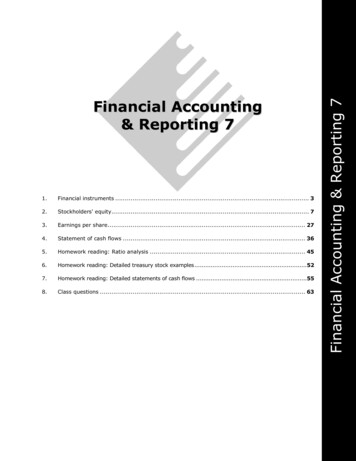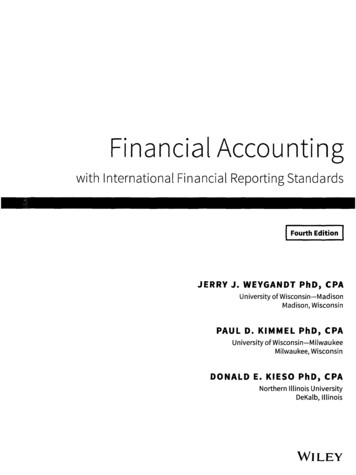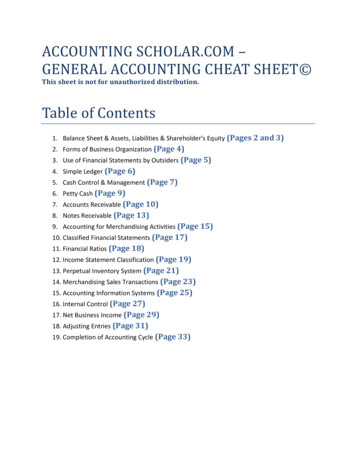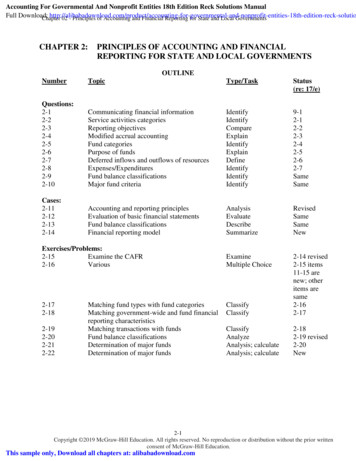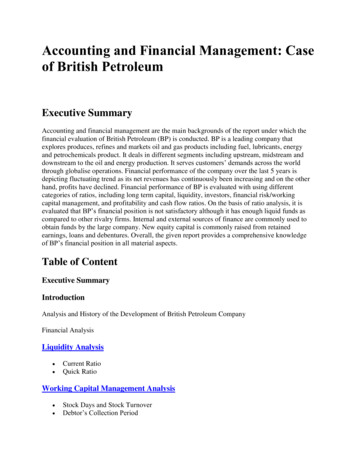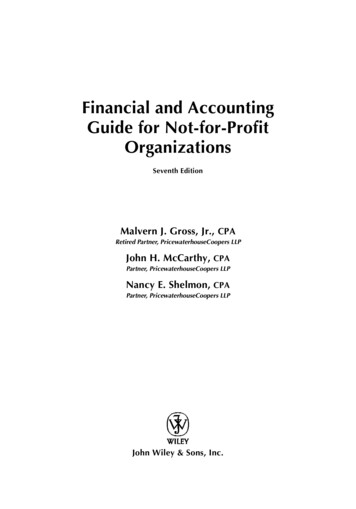
Transcription
Financial and AccountingGuide for Not-for-ProfitOrganizationsSeventh EditionMalvern J. Gross, Jr., CPARetired Partner, PricewaterhouseCoopers LLPJohn H. McCarthy, CPAPartner, PricewaterhouseCoopers LLPNancy E. Shelmon, CPAPartner, PricewaterhouseCoopers LLPJohn Wiley & Sons, Inc.
Financial and AccountingGuide for Not-for-ProfitOrganizationsSeventh Edition
Financial and AccountingGuide for Not-for-ProfitOrganizationsSeventh EditionMalvern J. Gross, Jr., CPARetired Partner, PricewaterhouseCoopers LLPJohn H. McCarthy, CPAPartner, PricewaterhouseCoopers LLPNancy E. Shelmon, CPAPartner, PricewaterhouseCoopers LLPJohn Wiley & Sons, Inc.
This book is printed on acid-free paper.Copyright 2005 by PricewaterhouseCoopers. All rights reserved.Published by John Wiley & Sons, Inc., Hoboken, New JerseyPublished simultaneously in CanadaNo part of this publication may be reproduced, stored in a retrieval system, or transmitted inany form or by any means, electronic, mechanical, photocopying, recording, scanning, orotherwise, except as permitted under Section 107 or 108 of the 1976 United States Copyright Act,without either the prior written permission of the Publisher, or authorization through paymentof the appropriate per-copy fee to the Copyright Clearance Center, Inc., 222 Rosewood Drive,Danvers, MA 01923, 978-750-8400, fax 978-646-8600, or on the web at www.copyright.com.Requests to the Publisher for permission should be addressed to the Permissions Department,John Wiley & Sons, Inc., 111 River Street, Hoboken, NJ 07030, 201-748-6011, fax 201-748-6008, oronline at http://www.wiley.com/go/permissions.Limit of Liability/Disclaimer of Warranty: While the publisher and author have used their bestefforts in preparing this book, they make no representations or warranties with respect to theaccuracy or completeness of the contents of this book and specifically disclaim any impliedwarranties of merchantability or fitness for a particular purpose. No warranty may be createdor extended by sales representatives or written sales materials. The advice and strategiescontained herein may not be suitable for your situation. You should consult with a professionalwhere appropriate. Neither the publisher nor author shall be liable for any loss of profit or anyother commercial damages, including but not limited to special, incidental, consequential, orother damages.For general information on our other products and services, or technical support, please contactour Customer Care Department within the United States at 800-762-2974, outside the UnitedStates at 317-572-3993 or fax 317-572-4002.Wiley also publishes its books in a variety of electronic formats. Some content that appears inprint may not be available in electronic books.Library of Congress Cataloging-in-Publication Data:Financial and accounting guide for not-for-profit organizations /Malvern J. Gross, Jr., . [et al.].— 7th ed.p. cm.Malvern J. Gross’s name appears as main author entry in earlier ed.Includes index.ISBN-13 978-0-471-72445-2 (cloth)ISBN-10 0-471-72445-9 (cloth)1. Nonprofit organizations—Accounting. I. Gross, Malvern J.HF5686.N56G76 2005657'.98--dc222005000045Printed in the United States of America10 9 8 7 6 5 4 3 2 1
To the millions of volunteerswho make the not-for-profit sectorand all of its achievements possible.
UpdateServiceBECOME A SUBSCRIBER!Did you purchase this product from a bookstore?If you did, it’s important for you to become a subscriber. John Wiley & Sons, Inc. maypublish, on a periodic basis, supplements and new editions to reflect the latest changesin the subject matter that you need to know in order to stay competitive in this everchanging industry. By contacting the Wiley office nearest you, you’ll receive any currentupdate at no additional charge. In addition, you’ll receive future updates and revised orrelated volumes on a 30-day examination review.If you purchased this product directly from John Wiley & Sons, Inc., we have alreadyrecorded your subscription for this update service.To become a subscriber, please call 1-877-762-2974 or send your name, companyname (if applicable), address, and the title of the product to:mailing address: Supplement DepartmentJohn Wiley & Sons, Inc.One Wiley DriveSomerset, NJ 02-2300www.wiley.comFor customers outside the United States, please contact the Wiley office nearest you:Professional & Reference DivisionJohn Wiley & Sons Canada, Ltd.22 Worcester RoadEtobicoke, Ontario M9W 1L1CANADAPhone: 416-236-4433Phone: 1-800-567-4797Fax:416-236-4447Email: canada@wiley.comJohn Wiley & Sons, Ltd.The AtriumSouthern Gate, ChichesterWest Sussex PO 19 8SQENGLANDPhone: 44-1243-779777Fax:44-1243-775878Email: customer@wiley.co.ukJohn Wiley & Sons Australia, Ltd.33 Park RoadP.O. Box 1226Milton, Queensland 4064AUSTRALIAPhone: 61-7-3859-9755Fax:61-7-3859-9715Email: brisbane@johnwiley.com.auJohn Wiley & Sons (Asia) Pte., Ltd.2 Clementi Loop #02-01SINGAPORE 129809Phone: 65-64632400Fax:65-64634604/5/6Customer Service: 65-64604280Email: enquiry@wiley.com.sg
About the AuthorsMalvern J. Gross, Jr. was the author of the first edition of this text and a significant contributor to many of the subsequent editions. He is a retired partner ofPrice Waterhouse (a predecessor to PricewaterhouseCoopers LLP) and a nationally recognized authority on accounting and financial reporting for not-for-profitorganizations. He was chairman of the AICPA Subcommittee on NonprofitOrganizations that wrote the 1978 landmark Statement of Position for CertainNonprofit Organizations, and of the Accounting Advisory Committee to theCommission on Private Philanthropy and Public Needs. He was a member of thecommittee that wrote the second edition of Standards of Accounting and FinancialReporting for Voluntary Health and Welfare Organizations, and a coauthor of theMuseum Accounting Handbook. He served as an advisor to the Financial Accounting Standards Board in the early phases of its work on setting accounting standards for not-for-profit organizations, and to the New York State CharitiesRegistration Office, as well as an adjunct professor of accounting at Lehigh University, his alma mater. After retirement from Price Waterhouse he was presidentof a not-for-profit organization, the National Aeronautics Association. He nowlives in the San Juan Islands off of the state of Washington.John H. McCarthy served as the National Leader of PricewaterhouseCoopers’Education & Nonprofit Practice before his retirement in 2005. He was a coauthorof the sixth edition of this text. He also is the coauthor of Understanding FinancialStatements: A Strategic Guide for Independent College and University Boards, published by the Association of Governing Boards of Universities and Colleges(1998), as well as several publications by PricewaterhouseCoopers including:The Changing Role of the Audit Committee (2004); Leading Practices for Colleges, Universities and Other Not-for-Profit Educational Institutions (2004); A Foundation forIntegrity (a 2004 guide for codes of conduct, conflicts of interest, and executivecompensation); Meeting the Challenges of Alternative Investments (2004); Understanding Underwater Endowment Funds (2003); and Financial Reporting and Contributions: A Decision Making Guide to FASB Nos. 116-117 (1996) among others. He isa CPA who, for more than 36 years, served PricewaterhouseCoopers’ educationand not-for-profit clients, including many of the most prestigious institutions inthe United States. He currently serves on several not-for-profit boards. He is apast president of the Massachusetts Society of CPAs, Inc. (MSCPA) and a twoterm member of the Governing Council of the AICPA. He has received numerous honors for his involvement in the community. He graduated from BostonCollege and has an MBA from the University of Michigan Business School.䡲vii䡲
ABOUT THE AUTHORSNancy E. Shelmon is a senior partner of PricewaterhouseCoopers LLP and is thefirm’s West Region Leader for the Education and Not-for-Profit Industry withinthe United States. Nancy is a frequent speaker at AICPA and state CPA conferences on financial reporting and accounting issues affecting not-for-profit organizations and is currently a member of the AICPA Not-for-Profit Expert Panel.She is currently Chair of the Planning Committee for the AICPA’s annual Notfor-Profit Conference. She has been serving education and not-for-profit clientsfor over thirty years and has been involved with some of the most widelyrespected organizations in North America. Nancy serves on the Board of Directors of the Los Angeles Urban League, the California Journal and Executive Service Corps of Southern California. In addition to being a CPA, she is also aCertified Fraud Examiner. She holds her accounting degree from the Universityof Minnesota.䡲viii䡲
ContributorsWe also want to recognize the many past contributions of Richard F. Larkin, whowas a coauthor of the fourth, fifth, and sixth editions of Financial and AccountingGuide for Not-for-Profit Organizations. Prior to his retirement from PricewaterhouseCoopers, he served as a technical director for the Education & Nonprofitpractice. We are very grateful to Dick for his efforts on prior editions of thisGuide.The seventh edition of this Guide represents the collaborative efforts of manyPricewaterhouseCoopers professionals who work with our not-for-profit clientsthroughout the United States. The authors wish to very gratefully acknowledgethe contributions of the following PricewaterhouseCoopers partners, directors,and managers to this Guide: Emily Bernhardt; Ted Budge; Amy Cloud; RalphDeAcetis; Diane Duncan; Kaye Ferriter; Cheryl Fletterick; Kevin Fordyce; MarthaGarner; Elaine Garvey; Dorian Gregory; Paul Hanley; Julie Henderson; SandraJohnson, Elisabeth Lippuner; Riva Mirvis; Layne Pinkernell; Christos Poulios;Robert Spear; Gwen Spencer; Jessica Vronman; and Frederick Wentzel, Jr. Theirassistance has been invaluable.䡲ix䡲
PrefaceThe authors have substantially revised the Financial and Accounting Guide forNot-for-Profit Organizations to create this seventh edition. The changes in the textreflect the ongoing evolution in not-for-profit accounting, financial reporting,and the systems that support it. The sixth edition was published when FinancialAccounting Standards No. 116 (accounting for contributions) and 117 (financialstatements of not-for-profit organizations) were still relatively new and as aresult it was written from the perspective of organizations that were making thetransition from “fund accounting” and financial reporting to the new “net asset”based financial reporting. The intent of the authors in the seventh edition is topresent a perspective of organizations that have now more fully integrated “netasset” accounting into their financial reporting. The authors have also attemptedto streamline all chapters to the extent appropriate while updating them for thelatest professional standards.Like its predecessors, the seventh edition has several objectives. The firstobjective is to help not-for-profit organizations better manage their financialresources. This starts with understanding—it’s easier to manage what you understand. Financial and accounting principles are often intimidating, but this Guidecovers the basics and shows that the principles make sense. The second objectiveis to help not-for-profit organizations better communicate their financial activities and financial condition to their stakeholders and the public.A common thread running through the chapters in the seventh edition is theneed for greater accountability and transparency in financial reporting by notfor-profit organizations. More than ever before, not-for-profit organizations mustbe accountable to their stakeholders, including, among many others, donors,lenders, regulators, and sponsors. Adapting to the new environment is a challenge, but one that the most successful not-for-profit organizations will understand and embrace.The seventh edition incorporates the current version of the new chaptersintroduced in the cumulative supplements to the sixth edition: “The External Financial Statement Reporting Model for Public Collegesand Universities and Other Not-for-Profit Organizations Reporting underGASB” (now Chapter 15), and “E-Business for Not-for-Profit Organizations: How Can Not-for-ProfitsManage the Risks to Manage E-Business Opportunities?” (now Chapter 27)䡲xi䡲
PREFACEThe other significant changes to the sixth edition include: Consolidation of former Chapters 6 and 7, each of which dealt with fixedasset accounting matters, into a single new Chapter 5, “Fixed Assets andDepreciation.” Consolidation of former Chapters 4 and 5, each of which dealt with fundaccounting, into a single new Chapter 4, “Fund Accounting and InternalFinancial Reporting.” Chapter 28, “Principal Tax Requirements,” in this edition includes all ofthe relevant information on taxes for not-for-profit organizations. Relevant information from former Chapter 29, “Principal Federal Tax FormsFiled,” has now been included in new Chapter 28. The actual tax formshave been deleted since these forms change each year and the authors feelthat readers would be better served to examine the actual forms issuedeach year by the Internal Revenue Service together with the applicableinstructions. Former Chapter 30, “State Compliance Requirements,” has been deletedfrom the Seventh Edition. Compliance requirements differ substantiallyby state, and with the impact that the Sarbanes-Oxley Act is having onvarious state regulations, the diverse issues that result are really beyondthe scope of an accounting and financial guide.The FASB’s project on combinations of not-for-profit organizations remainedopen when text went to print. As discussed in Chapter 7, the FASB expects toissue an exposure draft on this in early 2005.䡲xii䡲
ContentsChapter 1 Responsibilities for Fiscal Management1.11.21.31
Accounting Standards No. 116 (accounting for contributions) and 117 (financial statements of not-for-profit organizations) were still relatively new and as a result it was written from the perspective of organizations that were making the transition from “fund accounting” and financial reporting to the new “net asset” based financial reporting. The intent of the authors in the seventh edition is to




